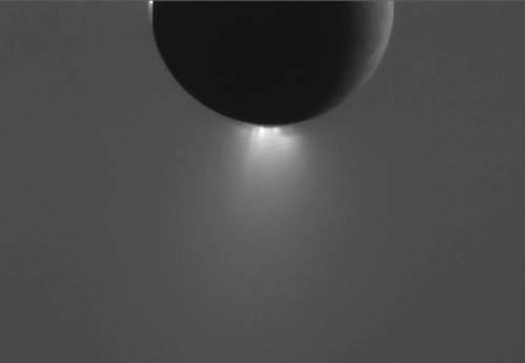In a Science paper published today, scientists from NASA’s Cassini mission to Saturn announced new findings that have big implications for the habitability of Saturn’s tiny, ice-covered moon Enceladus.
Spoiler alert: It’s not aliens. But in the geyser-like plumes that constantly spew out of Enceladus’s southern fissures, the team found molecular hydrogen (H2). This finding adds more evidence to the idea that on the floor of the moon’s ocean, liquid water percolates into the rocky core and drives chemical reactions similar to those found at hydrothermal vents on Earth.
Finding molecular hydrogen, in addition to carbon dioxide, methane, and other molecules that scientists had already detected in the plumes, means that “habitability, as the astrobiologists have defined it, is pretty much manifested in the interior ocean of Enceladus,” said lead author Hunter Waite, a planetary scientist at the Southwest Research Institute in San Antonio, Texas.
Hunting for Hydrogen
Cassini spotted Enceladus’s plumes in 2005, a year after the spacecraft entered Saturn’s orbit. But scientists weren’t sure where the plumes’ water came from. Since then, studies of Enceladus’s gravity indicate that the moon hosts a global ocean under its ice shell.
In 2015, Cassini detected nanometer-sized particles of silicon-rich material in Saturn’s rings. This was an odd finding because Saturn’s rings are composed mostly of ice. The researchers traced those particles—analyzed to be silicon dioxide, also known as silica—back to Saturn’s E ring, where Enceladus orbits. Cassini images had previously shown scientists that material from the plumes shoots into the E ring, so the researchers concluded that this silica must also be coming from Enceladus’s plumes.

In space, it’s rare to find floating bits of silica, but in Earth’s oceans, silica disperses from hot rock interacting with water at hydrothermal vents. Scientists suggested that hydrothermal reactions on Enceladus’s ocean floor must be releasing the silica, but they were missing a key indicator of hydrothermal activity: H2, a molecule seen in abundance around Earth’s hydrothermal vents.
In the new paper, researchers examined data from Cassini’s deep dive through Enceladus’s plumes in October 2015. Gas particles zoomed through Cassini’s Ion and Neutral Mass Spectrometer (INMS), which “you could call Cassini’s ‘nose,’” Waite said, because it “sniffs” the molecules in the plume to determine what they are. In this paper, the team’s data point to a wealth of H2 coming out of Enceladus’s oceans.
But there are other potential sources of hydrogen on Enceladus that wouldn’t involve hydrothermal vents, the paper notes. When the moon formed, billions of years ago, it could have incorporated hydrogen as part of its primordial material.
However, Waite said, vestiges of this primordial material are unlikely to be the source of this newly detected hydrogen. This is due to the relatively tiny hydrogen molecules’ ability to easily escape from substances. Enceladus is small, with a diameter only about one tenth the distance from Los Angeles to New York. So it couldn’t have held on to hydrogen from its formation, Waite noted. Any loose hydrogen would have leaked into space by now.
This leaves an internal origin for the hydrogen, which most likely comes from water interacting with minerals on a hot, rocky ocean floor, Waite explained.
Earth-Like Chemistry?
Enceladus is quite different from Earth. Earth, at more than 12,000 kilometers in diameter, is huge compared with Enceladus’s 504 kilometers and holds enough residual energy to heat its interior. Enceladus does not have hot, buoyant rock rising from its innards to heat a mantle or any magma pushing through a crust. Instead, scientists think that tidal stretching and squeezing of Enceladus by Saturn’s gravity cause friction that creates enough heat to support liquid water.
Finding hydrogen in Enceladus’s plumes suggests that the moon’s rocky core may be hot enough to drive chemical reactions with water that trickles through the moon’s seafloor into the porous interior, reactions similar to those found at hydrothermal vents, Waite said.
And the hint of hydrothermal vents is why the finding is so exciting. At Earth’s hydrothermal vents, bacteria and other creatures don’t need sunlight to create energy. Instead, these critters take advantage of the smorgasbord of chemical reactions happening around them, which result from water interacting with minerals in hot rock.
Methanogenic bacteria, for example, get energy from converting carbon dioxide and hydrogen—among other things—into methane. Waite said that the high level of hydrogen found in the plumes suggests that Enceladus’s ocean could be extremely rich in molecules necessary for this kind of reaction.
So “if you had those same conditions [at] a hydrothermal vent on Earth, methanogenic bacteria would be eating the hydrogen as if it were candy,” he continued. But this is all supposition; Waite stressed that there is no current evidence for life on Enceladus.
Until Next Time, Enceladus
“The Enceladus results provide a new location for potential life well outside the Goldilocks zone, that narrow region around a star where liquid water can exist on the surface of a planet,” said Linda Spilker, Cassini project scientist at NASA’s Jet Propulsion Laboratory in Pasadena, Calif., who was not involved in the research. Finding hydrogen means that “liquid water is chemically interacting with the rock beneath the ocean, producing the kind of chemistry that is favorable for potential life,” she said.
Because NASA plans to send the aging Cassini spacecraft plunging into Saturn in September, it’s goodbye to Enceladus for now. But it might not be goodbye forever: Future spacecraft may return to send us back more clues of the moon’s newfound Earth-like environment.
—JoAnna Wendel (@JoAnnaScience), Staff Writer
